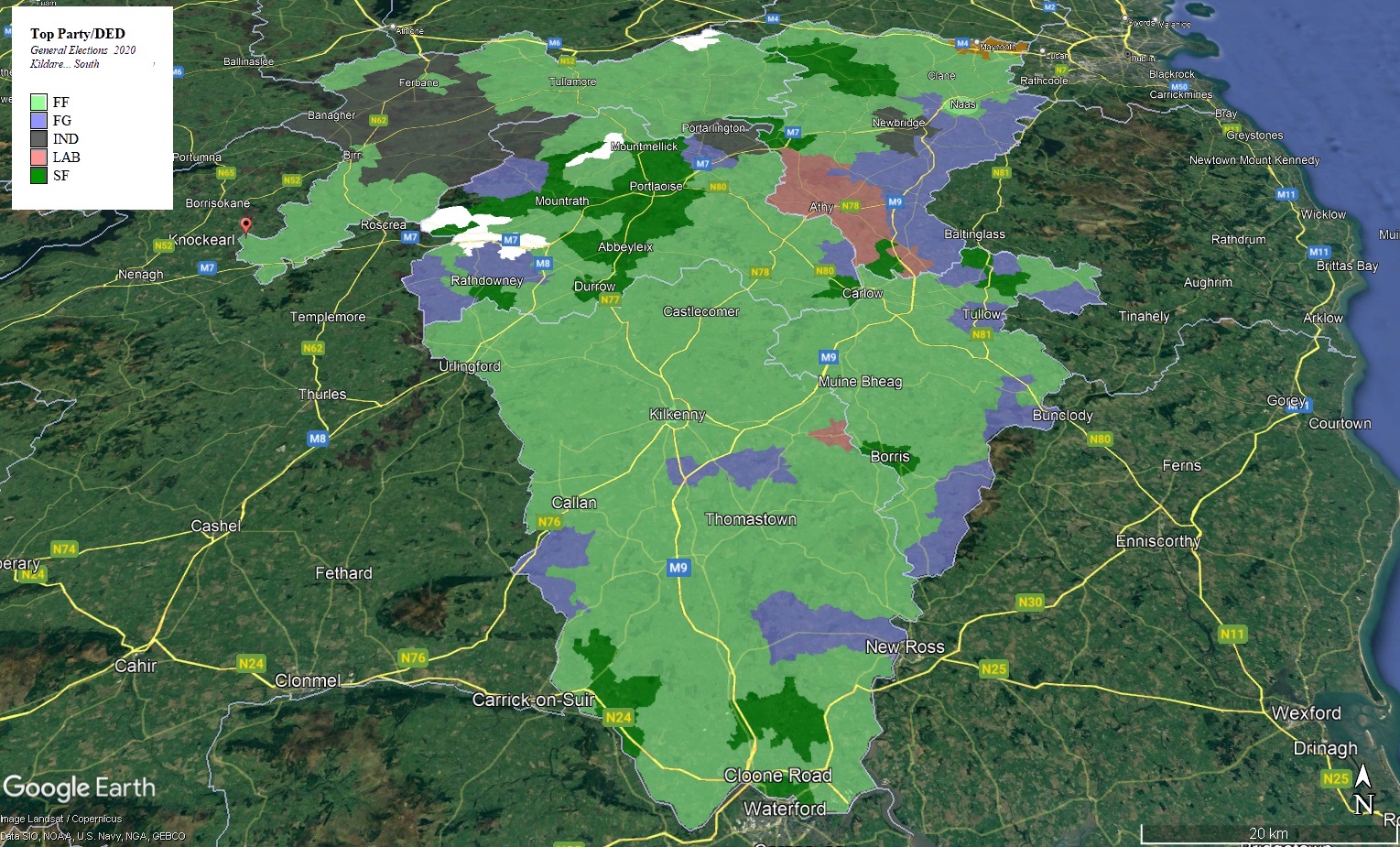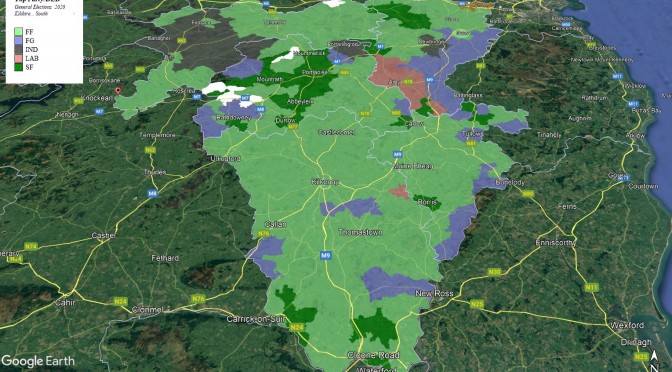In this post, I will be gradually working through the possible permutations of constituencies that the recently formed Electoral Commission might consider.
Unfortunately I’m slightly shooting blind, as the Terms of Reference merely state that “the total number of members of the Dáil, subject to Article 16.2.2° of the Constitution, shall be not less than 171 and not more than 181”. Apparently, the precise number of members the Dáil will not be set until after the Central Statistics Office releases the final population figures (sometime in the summer months) and will not be revealed until the Constituency Review report is released probably in the Autumn.
However, there seems to be a general concensus amongst people wiser than myself that the final number is likely to be somewhere between 176 and 181 in order to “future-proof” whatever scheme of constituencies is arrived at.
Accordingly, I have decided to ensure that my constituency examples below (examples – not proposals) would be within the permitted 5% variation from the National average of Population per TD for both 178 and 180 seat models.
Just to reiterate that these are examples of what the Electoral Commission MIGHT do, rather than what they WILL do – or indeed, what I think they SHOULD do.
VARIANCE
The below table shows the population limits (positive or negative) that for constituencies to be valid. Each constituency has to have a Population per TD ratio within 5% of the National Average.
TABLE 1 – PERMITTED VARIATIONS IN POPULATION FOR CONSTITUENCIES
| MAGNITUDE | 178 | 180 | ||
| Minimum | Maximum | Minimum | Maximum | |
| 3 seats | 82,034 | 90,669 | 81,123 | 89,662 |
| 4 seats | 109,379 | 120,892 | 108,164 | 119,549 |
| 5 seats | 136,724 | 151,116 | 135,204 | 149,436 |
TERMS OF REFERENCE
The Terms of Reference for the Electoral Commission are as follows.
- the total number of members of the Dáil, subject to Article 16.2.2° of the Constitution, shall be not less than 171 and not more than 181*;
- each constituency shall return 3, 4 or 5 members;
- the breaching of county boundaries shall be avoided as far as practicable.
- the reference to county boundaries shall be deemed not to include a reference to the boundary of a city or any boundary between any 2 of the counties of Dún Laoghaire-Rathdown, Fingal and South Dublin.
- each constituency shall be composed of contiguous areas;
- there shall be regard to geographic considerations including significant physical features and the extent of and the density of population in each constituency; and
- subject to the above matters, the Commission shall endeavour to maintain continuity in relation to the arrangement of constituencies.
The two important terms for me are Numbers 3 and 7, as logically interpreted it means that the integrity of county boundaries is prioritised over the continuity of current Constituency boundaries – including presumably those where county boundaries are breached.
As regards Number 2, I think it’s regrettable that larger constituencies are not permitted – besides allowing for a better share of representation, there is a reasonable case for their use in larger counties (ie Galway) or indeed in large cities (ie Dublin and Cork)
LEINSTER
I’m going to examine the Leinster counties in three distinct groups :
- Carlow, Kildare, Kilkenny, Laois and Offaly
- Cavan, Longford, Louth, Meath, Monaghan and Westmeath
- Wexford and Wicklow
The more eagle-eyed amongst you will have noticed that two Ulster counties are mentioned above. This is because the previous Boundary Commission crossed a provincial boundary to add seven District Electoral Divisions in Meath to Cavan-Monaghan.
CARLOW, KILDARE, KILKENNY, LAOIS AND OFFALY
Firstly, the reasoning behind choosing to group these five counties.
Carlow and Kilkenny have been joined together as a five-seat constituency for much of the last one hundred, although between 1937 and 1948 Carlow and Kildare were joined in a constituency.
Carlow and Kilkenny together have just about enough population for six seats (ie two three-seaters) but Carlow would need to take a substantial amount of population from rural Kilkenny (nearly 20,000) which would be very problematic to do in a way that would leave two well-formed constituencies.
There are two main issues to grapple with in this scenario – the central position of Kilkenny City in the County, and the fact that there is only two other towns with populations greater than 2,000 in the county – Thomastown in the East and Callan in the West.
Trying to connect Carlow with North Kilkenny would prove difficult given the comparative lack of transportation links between Carlow town and the main large village in the north-east of Kilkenny Castlecomer – they are joined by a regional road rather than a national one, and that road runs through Laois from Carlow for nearly ten miles before entering North Kilkenny. Also again, the sparse population density means that much of North Kilkenny would have to go into what would be a weirdly shaped three seat Carlow constituency with little geographic or social coherence.
Taking the part of Wicklow that intertwines with north-east Carlow wouldn’t greatly ameliorate the problem as the area is comparatively large but sparsely populated. Also Wexford and Wicklow have a fairly neat eleven seat allocation between them on the numbers and this area would be possibly be pivotal in allowing one county to host two three-seaters and the other to remain a five-seater.
Looking at Kildare, on the face of it the existing Kildare constituencies have a straightforward nine seats between them on the population figures (see Table 2). The difficulty arises however in that the current Laois-Offaly constituency doesn’t have quite enough population to allow stand-alone three seat constituencies in each county – but that could be solved by the movement of Portarlington (and surrounding rural areas to the south) out of South Kildare and back into Laois and Offaly.
TABLE 2 – POPULATION BY CONSTITUENCY
| CONSTITUENCY | POPULATION | 178 SEATS | 180 SEATS |
| Carlow-Kilkenny | 165,616 | 5.75 | 5.82 |
| Kildare North | 134,354 | 4.67 | 4.72 |
| Kildare South | 125,703 | 4.37 | 4.42 |
| Laois-Offaly | 161,245 | 5.60 | 5.66 |
In actual fact, Portarlington straddles the border of Laois and Offaly with about one-third of the town population living north of the border. Given that Laois has marginally too much population for a three-seater (see Table 3), this problem could be solved by moving the whole of Portarlington into the Offaly constituency.
In terms of population, Kildare would still be just within the permitted variance for 9 seats, but it would make sense to add part of south Kildare to Carlow to lessen the amount of population a three-seat Carlow constituency would need to take from Kilkenny.
There are strong links to support this proposition – the main village in the area (Castledermot) is closer to Carlow town than Athy and is connected by a better road – also the areas and settlements that would move into a Carlow constituency lie along the route of the M9 and also the old main road from Castledermot to Kilcullen which runs roughly parallel to it.
TABLE 3 – POPULATION BY COUNTY
| COUNTY | POPULATION | 178 SEATS | 180 SEATS |
| Carlow | 61,931 | 2.15 | 2.18 |
| Kilkenny | 103,685 | 3.60 | 3.64 |
| Kildare | 246,977 | 8.58 | 8.68 |
| Laois | 91,657 | 3.18 | 3.22 |
| Offaly | 82,668 | 2.87 | 2.90 |
The transfer of nearly nine thousand population from south-east Kildare into Carlow – and over twelve thousand into Laois and Offaly – would leave Kildare South with a population of just under One hundred and four thousand (103,821 to be precise). Kildare North as currently constituted has a population of 134,543.
To make Kildare North and Kildare South both four seaters (in 1 178 seat Dáil) would require a minimum population transfer of 13,561 from Kildare North. To make Kildare North a five-seater and Kildare South a three-seater would require a population transfer of at least 13,143.
On the face of it, each option seems equally possible, but a transfer from Kildare North-West would gave to come from the rural North-West of the constituency and – in order to reach the required population numbers – either of the towns of Kilcock or Clane would have to go into Kildare South, and both of those moves would be problematic.
To deal with Kilcock first, it like its near neighbours Leixlip, Maynooth and Celbridge is a M4 commuter and has grown rapidly over the last 20 years or so. It has no direct links with the other major towns in the south.
Removing Clane means that the only town with links to both Naas and the towns of the North-East is removed and indeed the only links between two areas within the constituency are by means of minor backroads.
CARLOW (3 seats)
The constituency of Carlow would consist of the whole county of Carlow as well as south-east Kildare (including the settlements of Ballitore, Castledermot, Moone and Narraghmore) and mid-east Kilkenny (including the settlements of Bennettsbridge, Inistioge, Graiguenamanagh, Gowran, Goresbridge, Paulstown and Thomastown.
TABLE 4 – CARLOW CONSTITUENCY DEDS
| COUNTY | DISTRICT ELECTORAL DIVISIONS | POPULATION |
| Carlow | ALL | 61,931 |
| Kilkenny (part) | Bennettsbridge, Bramblestown, Brownsford, Coolhill, Dysartmoon, Inistioge, Freaghanna, Famma, Graiguenamanagh, Gowran, Goresbridge, Kilfane, Paulstown, Powerstown, Rosbercon Rural, Shankill, The Rower, Thomastown, Tiscoffin, Tullaherin, Ullard, Woolengrange | 15,589 |
| Kildare (part) | Ballaghmoon, Ballitore, Belan, Burtown, Carrigeen, Castledermot, Dunmanogue, Graney, Grangemellon, Inchaquire, Narraghmore, Johnstown, Kilkea, Moone | 8,811 |
The M9 runs through the portion of South-East Kildare included in the constituency, through Carlow and through the northern part of the portion of mid-east Kilkenny. Admittedly some of the settlements (Graiguenamanagh, Inistioge) are at some distance from the M9, but there would have been similar problems if the transfer was pivoted to the North-East.
MAP 1 – PROPOSED CARLOW CONSTITUENCY
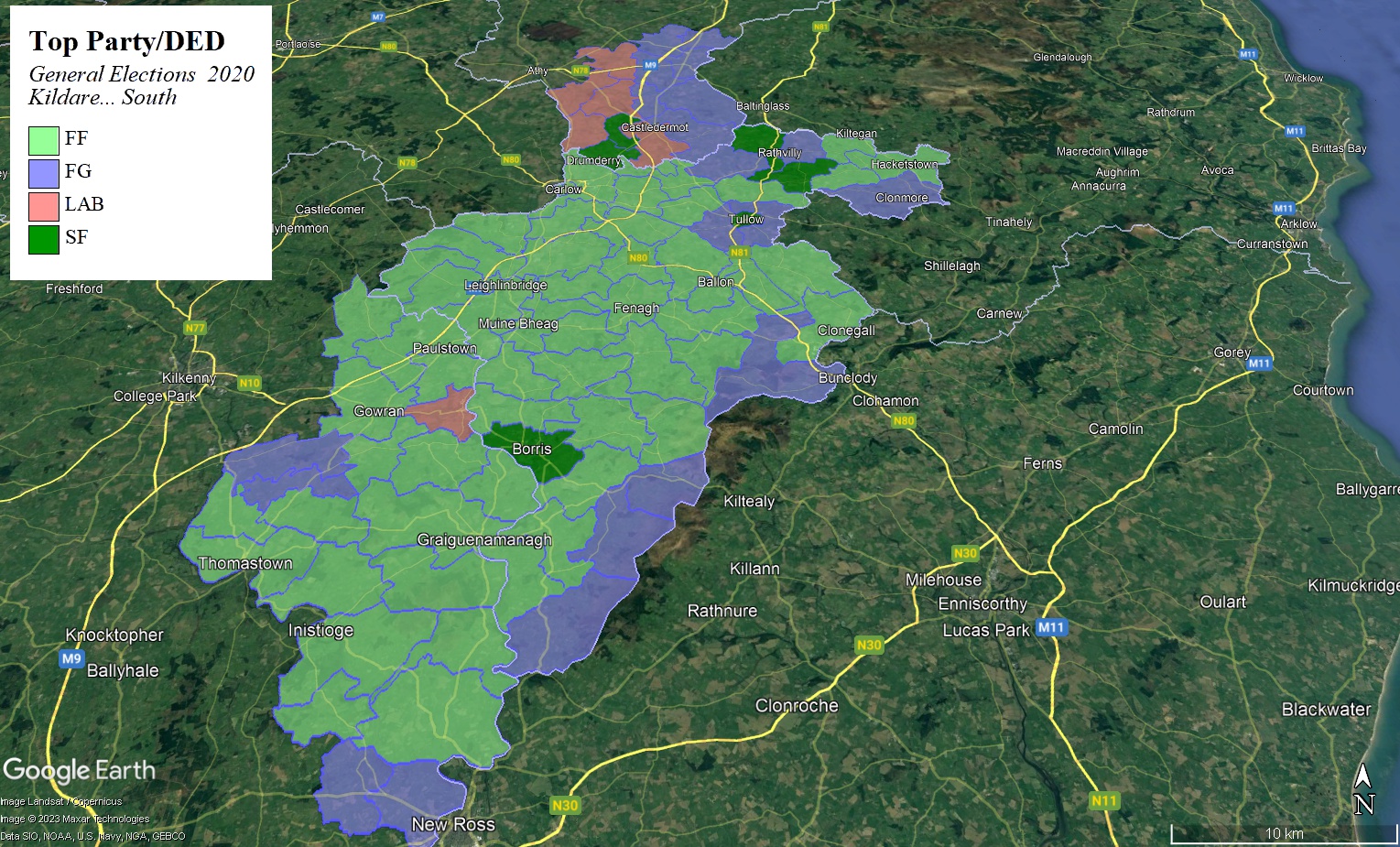
Fianna Fáil were the top-polling party through much of the constituency except in South Kildare where Fine Gael were ahead in the foothills of the Wicklow mountains to the east of the M9 (traditionally a strong area for Fine Gael) and Labour were ahead to the west of the M9.
Sinn Féin polled very well in Tullow, taking over 37% of the vote in Tullow Polling Station and 45% in the Urban boxes. Overall, Sinn Féin polled better in Carlow than they did in either the Kildare or Kilkenny portions of the constituency
TABLE 5 – PARTY SUPPORT BY LEA
| SF | FG | FF | GP | LAB | OTH | IND | % | |
| Muine Bheag | 26% | 23% | 38% | 4% | 4% | 4% | 1% | 24% |
| Carlow | 27% | 15% | 45% | 4% | 1% | 8% | 1% | 23% |
| Tullow | 28% | 28% | 33% | 3% | 2% | 6% | 1% | 23% |
| C-T’town (pt) | 20% | 28% | 33% | 7% | 6% | 3% | 3% | 15% |
| Athy (pt) | 21% | 25% | 16% | 2% | 25% | 1% | 5% | 10% |
| C’comer (pt) | 20% | 20% | 34% | 6% | 12% | 2% | 5% | 5% |
| TOTAL | 25% | 23% | 36% | 4% | 6% | 4% | 2% |
Overall, 70% of the votes came from Carlow in 2020, 20% from Kilkenny, and 10% from Kildare. It is likely -on the figures above – that such a constituency would return one seat apiece for Fianna Fáil, Fine Gael and Sinn Féin.
KILDARE NORTH (5 seats)
The constituency of Kildare North would consist of the Urban north-east of the county with additional rural areas in the North-West being transferred from Kildare South.
There are four large towns in the constituency; three (Maynooth, Leixlip and Celbridge) clustered along the M4, and further south Naas close to the N7. Other sizeable towns include Clane, Kilcock, Sallins and Kill.
The transfer from Kildare South will bring smaller settlements such as Allenwood, Ballymore, Coill Dubh, Derrinturn and Robertstown into the constituency.
TABLE 6 – KILDARE NORTH CONSTITUENCY DEDS
| CONSTITUENCY | DISTRICT ELECTORAL DIVISIONS | POPULATION |
| Kildare North | ALL | 134,543 |
| Kildare Sth (pt) | Ballymore, Carrick, Carbury, Donore, Drehid, Killashee, Kilmeague North, Kilpatrick, Kilrainy, Lullymore, Robertstown, Timahoe South, Windmill Cross | 14,740 |
The M4 runs along the Kildare-Meath border, while the R414 runs in a straight line across much of the south-west border of the constituency, before veering north-west towards Carbury and Derrinturn. The constituency would encapsulate much of the Bog of Allen area in Kildare. In the South-East, Ballymore would be naturally in the hinterland of Naas rather than any of the large towns in Kildare South.
MAP 2 – KILDARE NORTH CONSTITUENCY
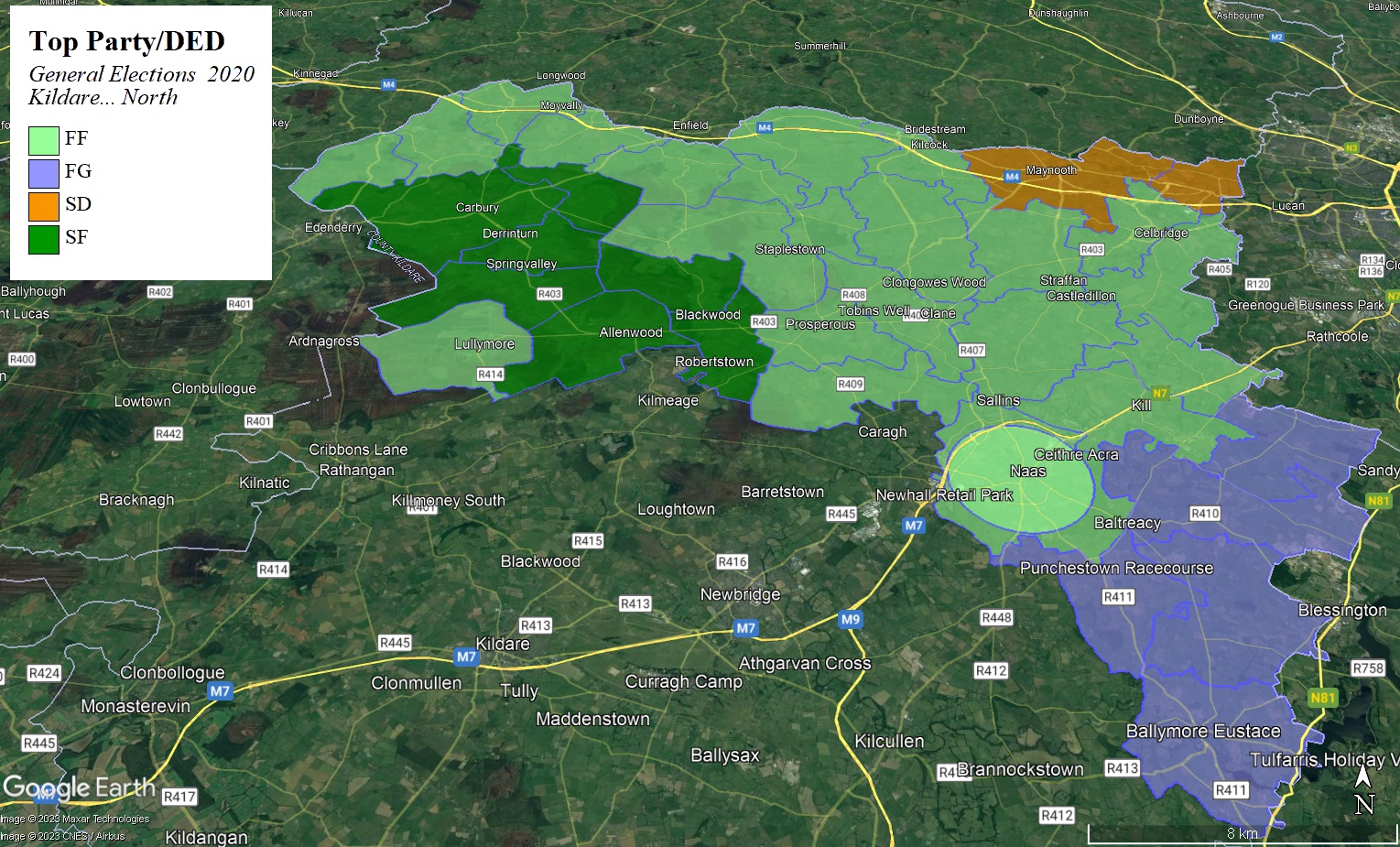
Fianna Fáil were the top-polling party in Celbridge, Naas, Sallins and Kilcock. They also topped the poll in Johnstownbridge and the rural North-West; but across the border Sinn Féin were ahead in much of the Bog of Allen which was formerly strong for Fianna Fáil.
The Social Democrats topped the poll in both Maynooth and Leixlip in the North-East
Fine Gael topped the poll in Kilteel and Ballymore along the border with Wicklow – this is the northern end of what historically was a strip of strong Fine Gael support in the Wicklow Mountains foothills which runs all the way down to Castledermot.
TABLE 7 – PARTY SUPPORT BY LEA
| SF | FG | FF | GP | LAB | SD | OTH | IND | % | |
| Naas(KN) | 17% | 21% | 31% | 13% | 4% | 11% | 4% | 1% | 28% |
| Maynooth | 15% | 20% | 23% | 11% | 8% | 19% | 3% | 1% | 19% |
| Celbridge | 19% | 13% | 28% | 8% | 7% | 21% | 4% | 1% | 17% |
| Leixlip | 16% | 15% | 17% | 6% | 4% | 38% | 3% | 1% | 14% |
| Clane(KN) | 20% | 19% | 29% | 8% | 5% | 14% | 3% | 1% | 12% |
| Clane(KS) | 32% | 18% | 27% | 3% | 4% | 5% | 4% | 8% | 8% |
| Naas(KS) | 15% | 37% | 15% | 7% | 7% | 3% | 4% | 9% | 2% |
| TOTAL | 18% | 18% | 26% | 10% | 5% | 18% | 2% | 2% |
Overall, 90% of the votes came from Kildare North in 2020, and 10% from areas in Kildare South.
On the above figures, Fianna Fáil, Fine Gael, Sinn Féin and the Social Democrats would be guaranteed one seat each, with the last seat probably between Fianna Fáil and the Greens.
Note how the Sinn Féin was much higher in the areas of Clane Electoral area that were in Kildare South than the areas in Kildare North. The area in Kildare South is mainly composed of communities clustered around the Bog of Allen which first showed high support for Sinn Féin in the local elections of 2014 – the same areas voted significantly for Ming Flanagan in the European Elections at the same time.
KILDARE SOUTH (3 seats)
The constituency of Kildare South would consist of the centre and south of County Kildare – bar the south-eastern strip which goes into Carlow.
There are three large towns in the constituency; two (Newbridge and Kildare) adjacent to the M7, and further south Athy. Other towns include Kilcullen, Monasterevin and Rathangan.
TABLE 8 – KILDARE SOUTH CONSTITUENCY DEDS
| CONSTITUENCY | DISTRICT ELECTORAL DIVISIONS | POPULATION |
| Kildare South | ALL except Ballymore, Carrick, Carbury, Donore, Drehid, Killashee, Kilmeague North, Kilpatrick, Kilrainy, Lullymore, Robertstown, Timahoe South, Windmill Cross AND Ballaghmoon, Ballitore, Belan, Burtown, Carrigeen, Castledermot, Dunmanogue, Graney, Grangemellon, Inchaquire, Narraghmore, Johnstown, Kilkea, Moone. | 89,072 |
The constituency is somewhat more rural than its northern colleague, and also has a slightly more working-class profile.
MAP 3 – KILDARE SOUTH CONSTITUENCY
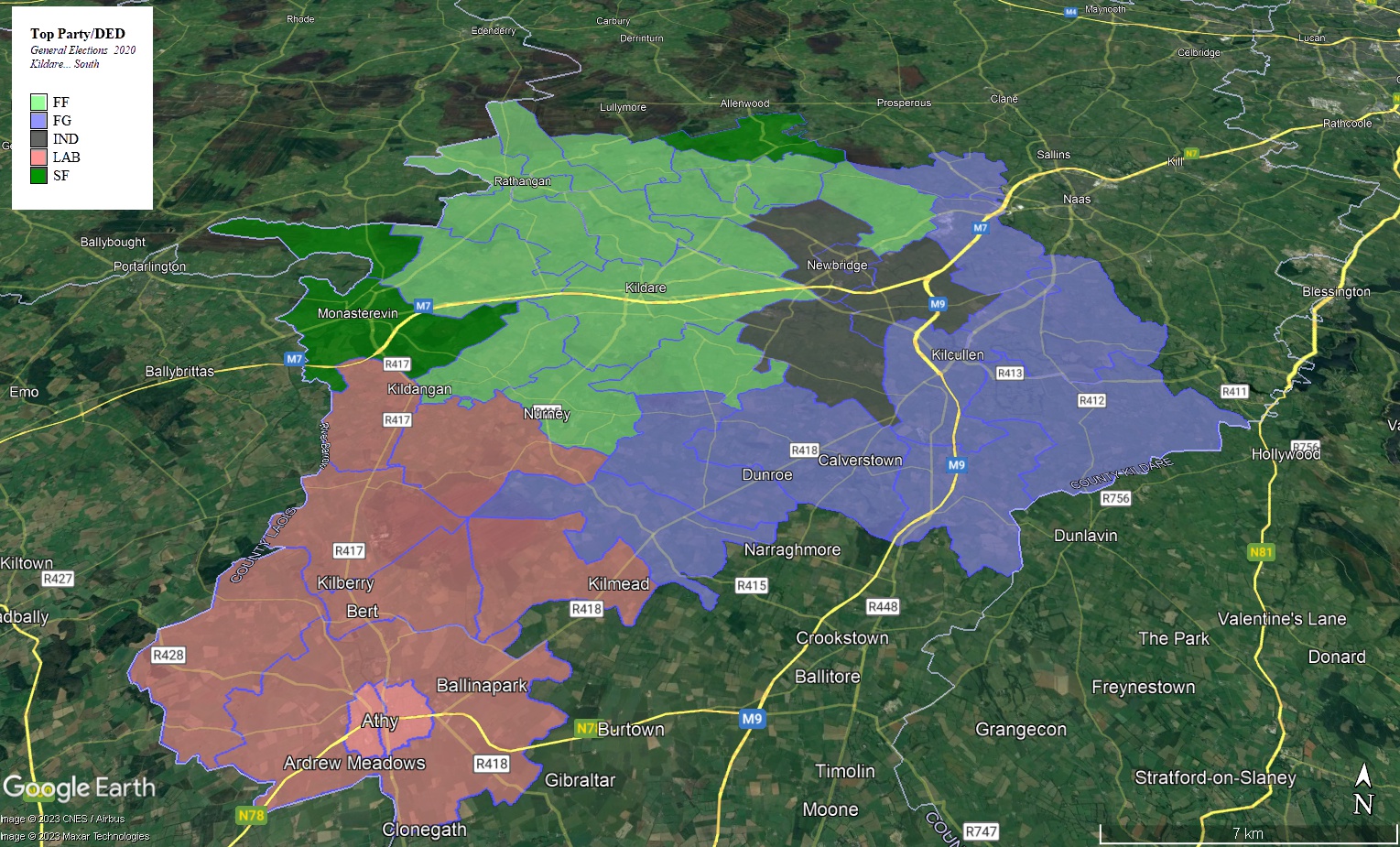
The poll-toppers were split three ways with Fianna Fáil ahead in its traditional stronghold in Kildare town and the west, Fine Gael ahead in the east in the good farming lands along the Wicklow border, and Labour dominating the vote in its Athy town bastion and its rural hinterland.
TABLE 9 – PARTY SUPPORT BY LEA
| SF | FG | FF | LAB | OTH | IND | % | |
| Newbridge | 17% | 19% | 20% | 4% | 12% | 27% | 42% |
| Kildare | 23% | 14% | 29% | 7% | 8% | 18% | 31% |
| Athy (pt) | 16% | 16% | 13% | 42% | 6% | 7% | 24% |
| Clane (pt) | 32% | 19% | 21% | 5% | 8% | 14% | 2% |
| TOTAL | 19% | 17% | 21% | 14% | 9% | 19% |
Three quarters of the vote were cast in central Kildare (the Newbridge, Kildare and Clane LEAs), while a quarter was cast in the south (Athy LEA).
The Labour vote was massively concentrated in Athy, where the party brand has been markedly impervious to the winds of change that have savagely buffeted the party since 2011. In that year the party took 50% of the vote in Athy town; in 2016, despite the electoral carnage that saw Labour lose over four-fifths of its seats, the party’s share in Athy fell by only two points to 48% (although they did lose their seat due to vote losses elsewhere in South Kildare). In 2020, despite the surge in Sinn Féin support, Labour’s vote in Athy rose by nine points to 57%; in West Athy, the most heavily working-class part of the town, their share was 63% to Sinn Féin’s 20%. They also attracted strong support in rural communities within a 10-mile radius of the town.
On the above numbers, you would probably expect 1 TD from each of Fianna Fáil, Fine Gael and Sinn Féin, but you couldn’t rule out Labour or an Independent taking a seat.
KILKENNY (3 seats)
The constituency of Kilkenny would consist of the whole county bar a mid-eastern section which goes into Carlow.
There is one large town in the constituency – Kilkenny – and one small town – Callan. Other sizeable settlements include Callan, Mooncoin, Piltown and Urlingford. In addition, the Ferrybank suburb of Waterford City extends over the border into the Kilculliheen DED of South Kilkenny.
TABLE 10 – KILDARE SOUTH CONSTITUENCY DEDS
| COUNTY | DISTRICT ELECTORAL DIVISIONS | POPULATION |
| Kilkenny | ALL except Bennettsbridge, Bramblestown, Brownsford, Coolhill, Dysartmoon, Inistioge, Freaghanna, Famma, Graiguenamanagh, Gowran, Goresbridge, Inistioge, Kilfane, Paulstown, Powerstown, Rosbercon Rural, Shankill, The Rower, Thomastown, Tiscoffin, Tullaherin, Ullard, Woolengrange | 88,096 |
Outside of Kilkenny, the constituency is largely rural, the only other settlement with more than two thousand population in 2016 being Callan.
MAP 4 – KILKENNY CONSTITUENCY
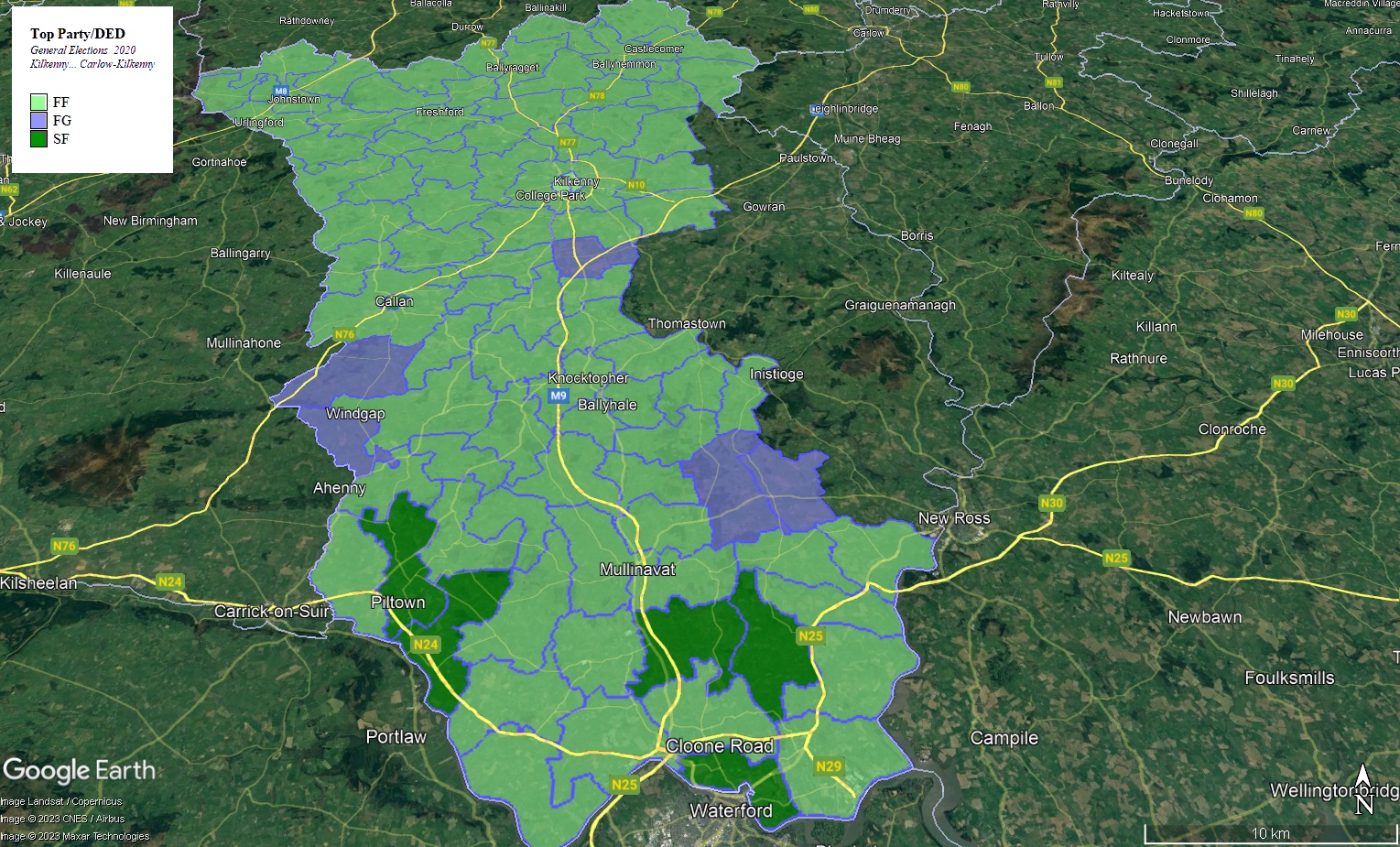
Fianna Fáil dominated much of Kilkenny both Urban and Rural. It is worth noting that Sinn Féin topped the poll in the area of Ferrybank north of the border with Waterford.
TABLE 11 – PARTY SUPPORT BY LEA
| SF | FG | FF | GP | OTH | IND | % | |
| Kilkenny | 21% | 16% | 36% | 16% | 4% | 6% | 28% |
| Castlecomer (pt) | 21% | 20% | 44% | 5% | 6% | 4% | 26% |
| Piltown | 30% | 23% | 34% | 4% | 7% | 2% | 26% |
| Callan-Thomastown (pt) | 18% | 27% | 38% | 8% | 5% | 4% | 19% |
| TOTAL | 23% | 21% | 38% | 9% | 6% | 4% |
Fianna Fáil were strongest in the northern LEA of Castlecomer, but polled consistently well across the area.
Sinn Féin polled best in Piltown in the south, and this was mainly due to votes from the extended Waterford suburbs and surrounding areas – they took nearly half the vote in Ferrybank National School, and also topped the poll in Bigwood and Piltown as well as just being just behind Fianna Fáil in Mooncoin
On the above numbers, you would probably expect 1 TD from each of Fianna Fáil, Fine Gael and Sinn Féin.
LAOIS (3 seats)
The constituency of Laois would consist of the whole county bar the part of Portarlington that lies south of the Laois-Offaly border. Other significant settlements include Mountmellick and the parts of Graiguecullen that lie west of the Laois-Carlow border.
TABLE 12 – KILDARE SOUTH CONSTITUENCY DEDS
| COUNTY | DISTRICT ELECTORAL DIVISIONS | POPULATION |
| Laois | ALL except Portarlington South | 83,707 |
Portlaoise sits roughly in the middle of the constituency. The Graiguecullen-Portarlington Local Electoral Area is unusual in that both of its sizeable Urban areas (the aforementioned Graiguecullen and Portarlington) straddle the border with neighbouring counties at opposite ends of the area.
MAP 5 – LAOIS CONSTITUENCY
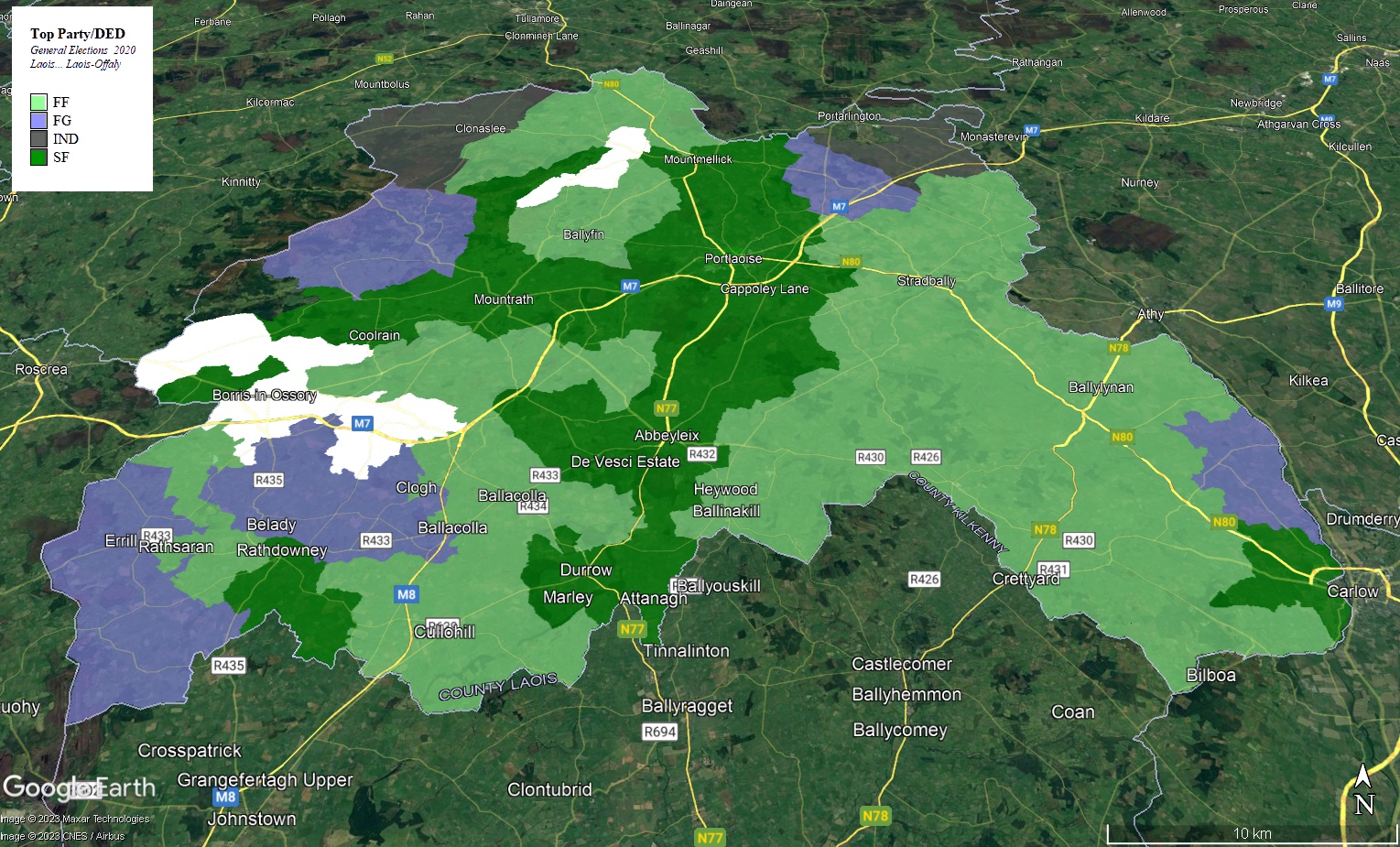
Most of the areas where Sinn Féin topped the poll are in Portlaoise or its general hinterland. A notable exception is the Laois portion of Graiguecullen where Sinn Féin polled 44% to 28% for Fianna Fáil and 14% for Fine Gael – across the border in Carlow, Fianna Fáil took 43% to 37% for Sinn Féin and just 7% for Fine Gael.
TABLE 13 – PARTY SUPPORT BY LEA
| SF | FG | FF | LAB | OTH | IND | % | |
| Portlaoise | 34% | 19% | 25% | 10% | 10% | 2% | 35% |
| Borris in Os.-M’mellick | 32% | 23% | 29% | 4% | 7% | 6% | 35% |
| G’cullen-Portarlington | 29% | 21% | 35% | 3% | 10% | 2% | 26% |
| G’cullen-P’rlington (KS) | 23% | 14% | 16% | 3% | 7% | 36% | 3% |
| TOTAL | 32% | 21% | 29% | 5% | 9% | 5% |
Sinn Féin were ahead in the west and centre of the country – the figures in the Borris-in-Ossory area were somewhat more surprising given that it is largely rural.
On the above numbers, you would expect 1 TD from each of Fianna Fáil, Fine Gael and Sinn Féin.
OFFALY (3 seats)
The constituency of Offaly would consist of the whole county as well as the whole town of Portarlington including the portion that lies within the county of Laois.
There is one large town in the constituency – Tullamore. Other sizeable towns include Edenderry and Portarlington in the east, Clara close to Tullamore in the centre of the constituency, and Birr in the west.
TABLE 14 – OFFALY CONSTITUENCY DEDS
| COUNTY | DISTRICT ELECTORAL DIVISIONS | POPULATION |
| OFFALY | ALL | 77,907 |
| LAOIS | Portarlington South | 7,856 |
Offaly is probably Ireland’s most irregularly shaped irregularly-shaped county, although there is a continuity with the Bog of Allen stretching across much of the north of the constituency and the south of the county separated from West Laois by the Slieve Bloom mountains and from North-West Tipperary (Lower Ormond by the Ballyfinboy and Little Brosna rivers.
MAP 6 – OFFALY CONSTITUENCY
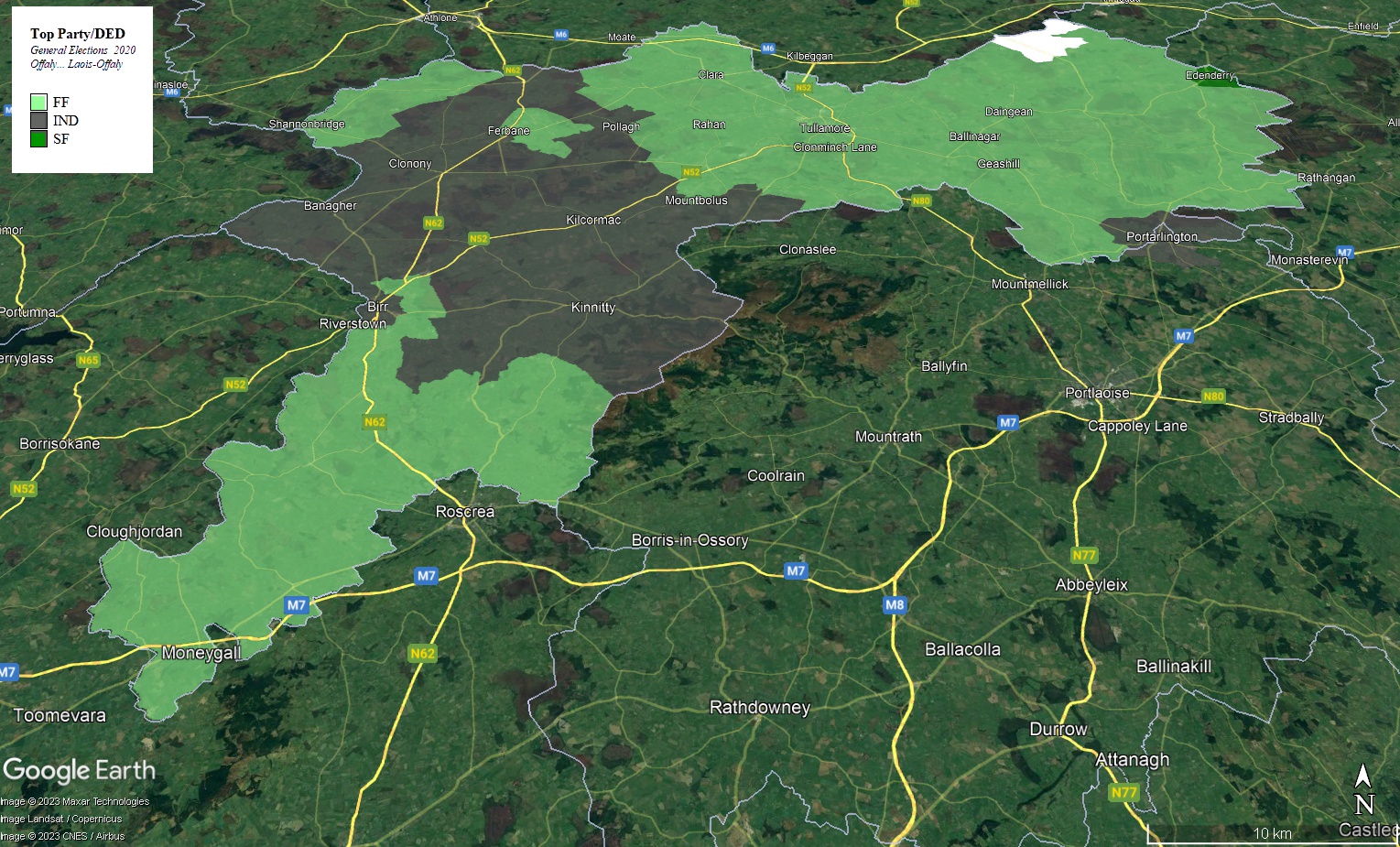
.Fianna Fáil were the poll-toppers in much of the county bar in the North-West where there were two prominent Independent candidates. Sinn Féin topped the poll in Edenderry with 31%; the Irish Democratic Party took 20%.
TABLE 15 – PARTY SUPPORT BY LEA
| SF | FG | FF | GP | OTH | IND | % | |
| Birr | 12% | 13% | 33% | 3% | 4% | 35% | 37% |
| Tullamore | 18% | 13% | 38% | 6% | 10% | 15% | 31% |
| Edenderry (L-O) | 25% | 15% | 30% | 7% | 15% | 8% | 23% |
| G’cullen-P’arlington (pt) | 30% | 7% | 11% | 3% | 7% | 42% | 7% |
| Edenderry (KS) | 28% | 6% | 13% | 2% | 6% | 46% | 3% |
| TOTAL | 19% | 13% | 32% | 5% | 8% | 23% |
Fianna Fáil polled consistently well across the area.
The Independent vote was largely corralled into the Western Birr area and particularly into the northern half of that area.
On the above numbers, you would probably expect 1 TD from each of Fianna Fáil, Sinn Féin and an Independent.
CONCLUSION
Below is the suggested set of six possible constituencies to replace the current four in South Leinster. Essentially Laois and Offaly would be split into two constituencies, gaining a seat in the process. A similar situation pertains to Carlow and Kilkenny. Kildare would retain eight seats, albeit Kildare North gaining a seat at the expense of South Kildare.
TABLE 16 – SUGGESTED CONSTITUENCIES
| CONSTITUENCY | SEATS | POPULATION | VAR178 | SF | FG | FF | OTH | IND |
| Carlow | 3 | 86,311 | — | 25% | 23% | 36% | 14% | 2% |
| Kildare North | 5 | 149,094 | +3.6% | 18% | 18% | 26% | 36% | 1% |
| Kildare South | 3 | 89,072 | +3.2% | 19% | 17% | 21% | 23% | 19% |
| Kilkenny | 3 | 88,096 | +2.0% | 23% | 21% | 38% | 15% | 4% |
| Laois | 3 | 83,707 | -3.1% | 32% | 21% | 29% | 14% | 5% |
| Offaly | 3 | 85,763 | -0.7% | 19% | 13% | 32% | 13% | 23% |
There would be population transfers amounting to 32,256 from three counties (Kildare, Kilkenny and Laois) into two other counties (Carlow and Offaly) to ensure all suggested constituencies are within the required 5% variation from the national average ratio of Population to TDs.
The largest transfer would be from Kilkenny to Carlow (21 DEDs; 15,589 population). The large number of DEDs is due to the low population density of many DEDs in rural east Kilkenny.
Fourteen DEDs (population 8,811) would be transferred from Kildare to Carlow.
And finally Portarlington South (population 7,856) would be transferred from Laois into Offaly.
Overall the percentage of people living in a DED who are living in a constituency not primarily based in their own county would be 5.5% ie roughly 1 in every 18.
MAP 7 – SOUTH-WEST LEINSTER
